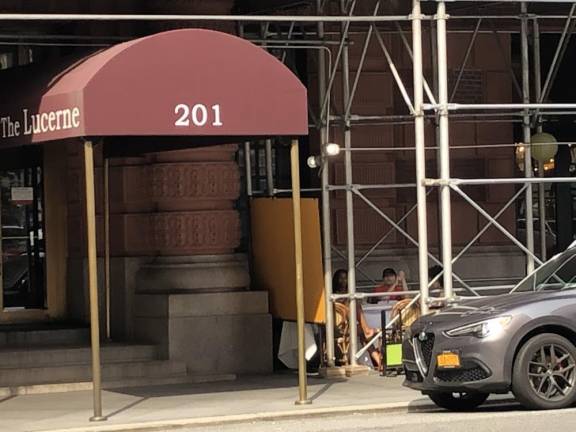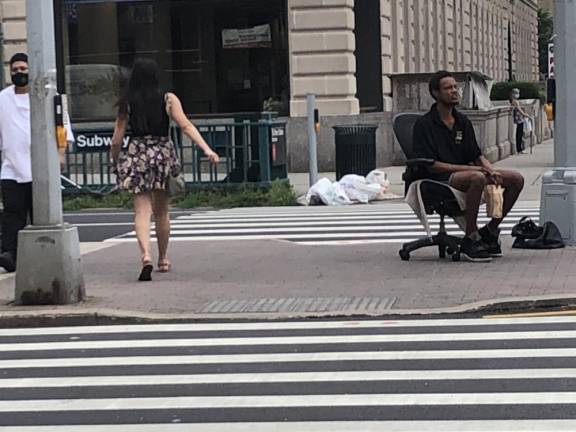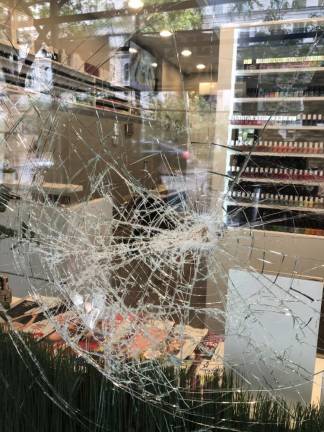Shelter from the Virus
Rising anger and anxiety on the UWS over homeless residents in neighborhood hotels



Near the northeast corner of 79th Street and Broadway, in plain sight of Banksy’s “Hammer Boy” mural, insulated by Plexiglass provided by Zabar’s, the older woman just lost it.
“Stop loitering,” she screamed through her anti-virus mask.
The target of her demand was a man who had been leaning against the wall of the DSW Designer Shoe Warehouse, sipping from a cardboard cup while chatting energetically, and unmasked, with an acquaintance.
The man straightened up and replied: “It’s a free country.”
Many things have changed on the Upper West Side in this time of COVID-19, but certainly not the readiness of residents and newcomers alike to debate the concerns of the day. None of the witnesses to this colloquy was able to establish whether the defender of free assembly was one of the 283 new residents of The Lucerne Hotel, now a shelter just up the block.
Probably, since longtime denizens of these streets are generally well known. Like Karl, whose principal residence appears to be the traffic island in the middle of Broadway at 79th St.
Karl’s photograph was featured prominently in the New York Post’s extensive coverage of the Lucerne’s new residents and the intense reaction of West Siders, who in the Post’s telling were trapped between their progressive politics and fear for their property values (or, on deeper reporting, their safety as well).
The Post did not share whether it had selected Karl’s photo as representative of the new arrivals, which he is not, or of the longtime residents, which in a sense he is, although without a proprietary lease.
For many in the neighborhood this muddle over Karl seemed to encapsulate a larger confusion. What was anecdote and what was trend? What was permanent and what passing?
No Notice
A clear part of the blame for this void of information fell on the de Blasio administration, which gave no notice of the conversion to shelters of the Lucerne and two other hotels in the neighborhood.
“The city can’t slip 700 homeless people into local hotels and expect the community not to notice,” Senior Rabbi Robert Levine of Congregation Rodeph Sholom told Jewish Week.
He noted that for 36 years his temple has offered shelter to the homeless. “We would have been sympathetic and helpful,” he said in a note to Straus News, “but would have had questions about security staffing and how to ensure that our kids could walk to the Rodeph Sholom School right across the street without being hassled.”
For its part the city’s Department of Homeless Services offered no apology for what it says were emergency measures to block the spread of coronavirus by moving people out of crowded, dormitory type shelters. “Our strategies have saved lives,” a spokesman said.
DHS pledged, however, “to maintain an open dialogue with the community to ensure concerns about these temporary relocations ... are addressed as they arise.” DHS said the community will be notified when “public health guidance determines that clients can be relocated back to our congregate shelters.”
The department did not say who would make this public health determination or what guidelines would be followed in reaching it.
At his briefing with reporters Monday, Mayor DeBlasio said “we’re going to start the process of figuring out where we can get homeless individuals back into safe shelter facilities and reduce the reliance on hotels.” In response to questions, he offered no timeline, but said:
“Hotels is certainly not where we want to be in general and we’re going to start that process immediately.”
All told some 60 hotels across the city have been converted to temporary shelter for New Yorkers with no other place to live.
The moves into the three West Side hotels was spread over nearly three months and thus leaves unanswered why some notice to the neighborhood and local leaders was not possible.
The first of the three hotels to take in residents from the shelters, on May 3, was the Belleclaire, on Broadway at 77th St. In recent years it has catered to European tourists. The Belleclaire took in 238 residents, including 100 women. About a third of the residents have jobs, city officials reported, although several were on the list of sex offenders and have since been moved.
On May 28, The Belnord, on 87th St. between Broadway and Amsterdam, took in 100 men, many with substance abuse and mental health challenges who came from a shelter in the Bronx.
The move to the Lucerne was two months after that, on July 27. The men in the Lucerne were moved from two shelters on the Lower East Side.
Unsettling Events
The use of the Belleclaire and Belnord as shelters drew some community notice. But nothing like the furor that has followed the conversion of the Lucerne.
The timing coincided with other unsettling events. For example, two women were attacked within a few days in the 72nd St. subway station. One was stabbed in the back. She was treated for a minor wound and a few days later a suspect was arrested. The other was punched in the back.
This spun up anxiety, and a number of residents noted they had been expressing concern about street encampments near the subway entrance before the pandemic – a worry that has only intensified as the transit system evicted the homeless overnight so trains and stations could be cleaned.
Last Thursday night, someone smashed the storefront windows of a nail salon and a hair salon on Broadway between 78th and 79th streets.
Perhaps more than anything it was the city starting to reopen that was most palpably different between May, when the Belleclaire and Belnord became shelters, and the end of July. Mentioned more than anything was concern of local parents about their kids, many now considering a return to school, being exposed to the shelter residents.
There has been a spike in complaints to the city’s 311 hotline. But reports of serious crime remain down, for the most part, in the Upper West Side precincts, the 20 and 24.
“If we purport to care about societal ills like poverty and mass incarceration, shunning these homeless men surely goes against our values,” Lauren-Brooke Eisen of the Brennan Center wrote in the Daily News. “It also flies in the face of data and evidence, which indicate that their views are based on fear and not reality.”
Overall, she said, crime on the West Side is down 10% since last year. For those who worry about a return to the bad old days, crime is down 85% from thirty years ago, according to NYPD data.
This longer view brings up a reason why shelters on the Upper West Side draw a conversation unlike others.
Few places on earth feature a higher per capita presence of writers, artists and intellectuals ready to reflect on the problems of urban life. This is, after all, the neighborhood where gang turf wars were reimagined into a romantic musical. What other community can claim to have launched both neo-conservatism and Jerry Seinfeld?
Indeed, while progressive politics are prevalent, the neighborhood is also home to quite a number of right-of-center thinkers and writers, whose analysis of the shelter controversy has been prominently featured in the editorial pages of the Post and its higher-brow cousin, the Wall Street Journal.
Thus the endless struggle between the order and authority respected on the right and the left’s search for empathy and equity comes full circle to Karl on the traffic Island in Broadway at 79th St. A neighbor approached him to solicit his thoughts on the current crisis. He apologized for being too busy to talk. “I have a math problem.”